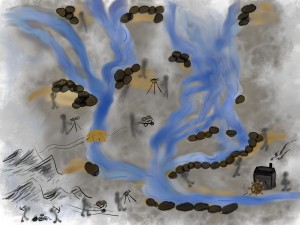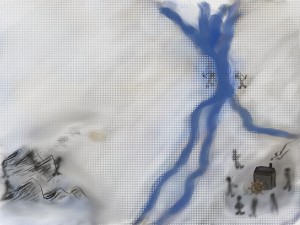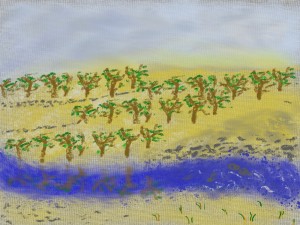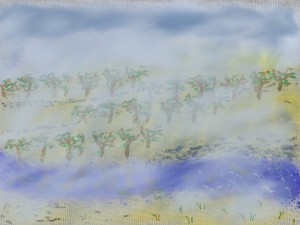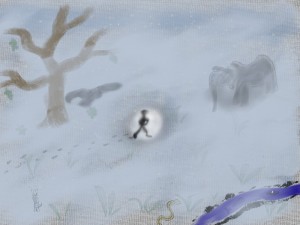There have been some interesting conversations at CSAG lately about the importance of paying attention to the rhetoric and framing we use in some of our ongoing discussions and investigations, but balanced against the importance of doing this without getting trapped by our metaphors, and/or evaluating what we do/have by how well it maps to what we want to be able to say about it. At the same time I’ve been trying to sketch out for myself some of the approaches taken towards uncertainty in climate science both in terms of research goals and the degree to which we tend to operate as if these goals were closer to being meet than they probably are. So trying to balance the two considerations I ended up with the following illustrations. While these are a result of me trying to develop my thoughts, and I of course have my reasons for all the individual elements in each composition, but I’m going to try not to deconstruct them to much here, the attempt is to be expressive rather than prescriptive. Although, as the heading image suggests, I’m less interested in if you read this blog, I mostly just want you to watch Ёжик В Тумне, (the video in the link has subtitles) and maybe consider that the adventures of the little hedgehog aren’t that different from our own.
People often talk about the “cascade of uncertainty”, refering to an expansion of possibilities due to uncertainty about the the state and mechanisms of the climate system. Typically this starts with different scenarios for external forcing, essentially greenhouse gas concentrations, each of which the global climate system could respond to in a variety of ways. These different ‘global climates’ have various combinations of regional manifestations, each of which has a multitude of possible consequences on local scales. This constant forking of the stream of possibilities is the ‘cascade’. This isn’t so much a representation of how the climate system itself ‘works’, the earth system is a complex, open system, with the movement of butterfly wings in Brazil creating hurricanes in China, etc, and how the patterns that get called climate are built from and interact with/within all this is, well, complex. What’s being expressed is that for investigations within such a system, a particular condition does not have a uniquely defined manifestation.
So when researching and/or working within such a system, the idea is to start with “anything is possible” and allow our understanding of mechanics to express what is ‘realistic’ [the streams tend to go in certain directions from their varied starting points], and then constrain these multiple possible realities, where possible, to those that based on observations appear to be most relevant [diligent “data miners” in the bottom left corner providing sandbags that the shadow scientists use to direct the flow of possibility]. In the end the various streams of possibility have been organised, predictions have been made, and the wheels of progress turn on [bottom right]. This sort of image is often presented as the idealised landscape of climate science. Multiple simulations mapping out what is possible, constrained, tuned, and evaluated by observational products, feeding this knowledge into practical applications.
The realisation of this, however, sometimes leaves something to be desired.
Typically the range of available simulations is limited, and often by construction, quite similar to each other. Rather than being able to say: “these are all the realistic possibilities”, instead there’s what we have a picture of, and there’s the either[1]. Often these simulations are quite removed from the actual observations, and how to bridge this gap is unknown. Rather we see most of the activity being redirected towards implementations that may or may not be located anywhere near the stream of possibility [as well the data miners from before now appear to be data explorers].
The most important thing though about this second picture, however, is that I made it by erasing or cutting-and-pasting elements from the first. I understand the situation in this way because I’m describing it based on the elements I expected to find in my ideal landscape. Although, this is still an improvement from taking this situation and acting like we’ve already achieved the first.
OK, so have a limited representation of possibility/reality, of limited information content regarding what I feel I need to know about. What to do with this? There seems to be two valid directions to go from here.
The first direction is to see what ‘what we have’, or more flatteringly, ‘the state of the science’ has to offer.
Some parts of the landscape here are reflected in the stream, and other parts are too far away. Some parts of the stream are able to reflect (imperfectly) the nearby landscape and some are too ‘chaotic’, but even this gives some important hints as to what the nearby landscape may be like [the rapids are near the rocky shore]. It’s a question of finding what is signal and what is noise, keeping in mind that signals are not defined by being mirror images, but rather by being ‘informative’.
Of course even this is an idealised scenario, some circumstance will be more amenable to this sort of analysis than other, there are many of sources of variability which makes many of these relationships opaque or inconsistent.
As well, this is coming from the angle of “we have this, what can we do with this?”. This is a very pragmatic approach, and given limitations in our ability to understand and/or agree on what sort of information we actually need, at times a useful limiting structure.
On the other hand, though, often our own situations are the starting points and grounding factors for our investigations. What if we’re not interested in what the information streams wash up on our shores, but where they can take us? Then we have to take where we are, and what we’re looking to do, as the starting point, and accept the uncertainties that mean we can’t see very far in any direction as the baseline condition. That’s not dissimilar from the starting point of the cascade of uncertainties landscape, but here we’re less interested in mapping out the full ‘possibility space’, but rather trying to quantify limits of predictability so that we don’t out run our range of vision, and in trying to imagine what might be out there, to help us guess what murky shapes and signs in this fog of uncertainty are warnings and which are benign. Occasionally we might even find a hilltop to count stars from.
Footnotes: 1. Regarding situations on local/regional levels. This isn’t a discussion of questions regarding CO2 and the Earth’s energy balance, but rather the scales of information that people want to use for planning and decision making.

